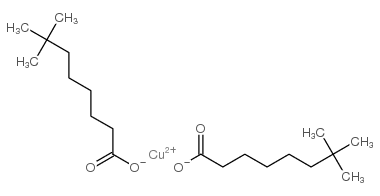neodecanoic acid, copper salt
Modify Date: 2025-08-24 21:20:45

neodecanoic acid, copper salt structure
|
Common Name | neodecanoic acid, copper salt | ||
|---|---|---|---|---|
| CAS Number | 50315-14-5 | Molecular Weight | 406.05900 | |
| Density | N/A | Boiling Point | 265.6ºC at 760 mmHg | |
| Molecular Formula | C20H38CuO4 | Melting Point | N/A | |
| MSDS | N/A | Flash Point | 121.3ºC | |
| Name | Copper(II) neodecanoate, superconductor grade, ~60% in toluene (6-12% Cu) |
|---|---|
| Synonym | More Synonyms |
| Boiling Point | 265.6ºC at 760 mmHg |
|---|---|
| Molecular Formula | C20H38CuO4 |
| Molecular Weight | 406.05900 |
| Flash Point | 121.3ºC |
| Exact Mass | 405.20700 |
| PSA | 80.26000 |
| LogP | 3.46330 |
|
Section 1: Product Identification Chemical Name:Copper (II) neodecanoate, superconductor grade, approx. 60%in toluene (6-12% Cu) CAS Registry Number:50315-14-5 Formula:Cu(OOC10H19)2 EINECS Number:none Chemical Family:metal carboxylate Synonym:Neodecanoic acid, copper (+2) salt
Section 2: Composition and Information on Ingredients IngredientCAS NumberPercentACGIH (TWA)OSHA (PEL) Title Compound50315-14-560%no datano data toluene108-88-340%50ppm300ppm (ceiling limit) Section 3: Hazards Identification Harmful by inhalation and if swallowed. Irritating to skin, eyes and respiratory tract. May be absorbed through Emergency Overview: the skin. Possible risk of irreversible effects. May impair fertility. Primary Routes of Exposure:Eye, skin, ingestion and inhalation. Eye Contact:Causes severe irritation to the eyes with redness and pain. Skin Contact:Causes slight to mild irritation of the skin. May be absorbed through the skin. Harmful by inhalation. Irritating to the nose, mucous membranes and respiratory tract. May cause confusion, Inhalation: headaches, dizziness, fatigue. Ingestion:Harmful if swallowed. May cause abdominal spasms. Irritating to skin, eyes and respiratory tract. Inhalation or ingestion may lead to fatigue, confusion, headache, Acute Health Affects: dizziness and drowsiness. High concentrations may cause unconsciousness and death. Chronic exposure to toluene include anemia, decreased blood cell count and bone marrow hypoplasia. Liver Chronic Health Affects:and kidney damage may occur. Prolonged contact can cause drying of the skin, redness and dermatitis. May impair fertility. Possible risk of irreversible effects. NTP:No IARC:No OSHA:No SECTION 4: First Aid Measures Immediately flush the eyes with copious amounts of water for at least 10-15 minutes. A victim will need Eye Exposure: assistance in keeping their eye lids open. Get immediate medical attention. Wash the affected area immediately with water. Remove contaminated clothing if necessary. Seek medical Skin Exposure: assistance if irritation persists. Remove the victim to fresh air. Closely monitor the victim for signs of respiratory problems, such as difficulty Inhalation: in breathing, coughing, wheezing, or pain. In such cases seek immediate medical assistance. Seek medical attention immediately. Keep the victim calm. Give the victim water (only if conscious). Induce Ingestion: vomiting if directed by medical personnel. SECTION 5: Fire Fighting Measures Flash Point:no data Autoignition Temperature:422°C (toluene) Explosion Limits:not determined Extinguishing Medium:dry chemical, carbon dioxide, water spray or foam. Fire fighters should be equipped with a NIOSH-approved positive pressure self-contained breathing and full Special Fire Fighting Procedures: protective clothing. Hazardous Combustion andcarbon dioxide, carbon monoxide, soot, organic vapors, and copper oxide Decomposion Products: Unusual Fire or Explosion Hazards: Flammable. No unusual fire or explosion hazards. SECTION 6: Accidental Release Measures Small spills can be absorbed into vermiculite or other suitable adsorbent. Larger spills must be contained in Spill and Leak Procedures:order to avoid contamination of the soil, sewers systems or bodies of water. Eliminate all potential ignition sources. Absorb the material into clay, sawdust or other suitable adsorbent. SECTION 7: Handling and Storage Handling and Storage:Store in a cool, dry, well-ventilated area away from heat and direct sunlight. Keep containers tightly sealed. SECTION 8: Exposure Controls and Personal Protection Always wear safety glasses. If pouring or transferring this substance wear a face shield for additional Eye Protection: protection. Skin Protection:Wear protective clothing and gloves. Consult with glove manufacturer to determine the proper type of glove. Ventilation:Work with this product in a well-ventilated area, preferably a fume hood. If ventilation is not available a respirator should be worn. The use of respirators requires a Respirator Respirator: Protection Program to be in compliance with 29 CFR 1910.134 Ventilation:Work with this product in a well-ventilated area, preferably a fume hood. Additional Protection:No additional protection required. SECTION 9: Physical and Chemical Properties Color and Form:dark green liq. Molecular Weight:406.03 Melting Point:no data Boiling Point:no data Vapor Pressure:no data Specific Gravity:no data Odor:toluene odor Solubility in Water:insoluble SECTION 10: Stability and Reactivity Stability:air and moisture stable liquid Hazardous Polymerization:no hazardous polymerization Conditions to Avoid:none Incompatibility:oxidizing agents Decomposition Products:carbon dioxide, carbon monoxide, organic fumes, and copper salts. SECTION 11: Toxicological Information For toluene: Oral (human); LDLo: 50mg/kg. Inhalation (human); TCLo: 200ppm. Oral (rat); LD50: 636mg/kg. Intraperitoneal (rat); LD50: 1332mg/kg. Intravenous (rat); LD50: 1960mg/kg. Oral (rat); TDLo: RTECS Data: 42380mg/kg/49D-I. Inhalation (rat); TCLo: 1600ppm/20H/7D-I. Material has effects on liver, reproductive systems, and blood. See RTECS #XS5250000 for additional information. Carcinogenic Effects:No reported carcinogenic effects Mutagenic Effects:Animal studies indicate that toluene may act as a mutagen. Tetratogenic Effects:No reported Teratogenic effects SECTION 12: Ecological Information Ecological Information:In significant quantities toluene may be toxic to aquatic life. SECTION 13: Disposal Considerations Dispose of according to local, state and federal regulations. For purposes of shipping waste material see the Disposal: section 14 in this document on transportation. SECTION 14: Transportation Shipping Name (CFR):Flammable liquids, N.O.S. Hazard Class (CFR):3 Additional Hazard Class (CFR):NA Packaging Group (CFR):III UN ID Number (CFR):UN# 1993 Shipping Name (IATA):Flammable liquid, N.O.S. Hazard Class (IATA):3 Additional Hazard Class (IATA):NA Packaging Group (IATA):III UN ID Number (IATA):UN# 1993 SECTION 15: Regulatory Information TSCA:Listed in the TSCA inventory. SARA (Title 313):Title Compound: See Category Code N100 for reporting. Second Ingredient:Toluene listed in TSCA. Reportable under SARA 313 SECTION 16 - ADDITIONAL INFORMATION N/A |
| Copperneodecanoatesuperconductorgradecaintoluene |
| Neodecanoicacid,coppersalt |
| Einecs 256-536-2 |
| Copperneodecanoate |